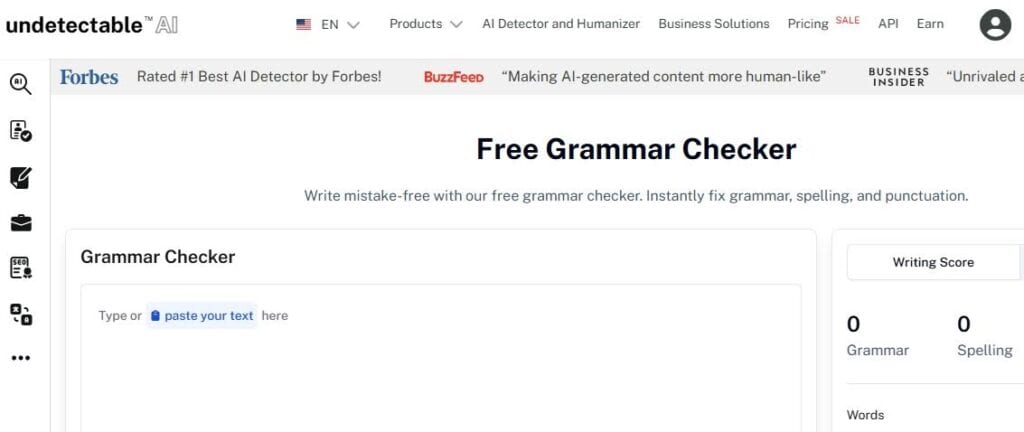Is it “happier” or “more happy”?
You’ve used both. We all have.
Sometimes one sounds better. Sometimes, both sound wrong. Sometimes you just rewrite the sentence to avoid the issue altogether.
Comparative adjectives are a part of almost everything we say.
However, they are strange. The rules exist, but they’re not always clear and definitely not always consistent.
So if you’ve ever paused mid-sentence wondering if you’re accidentally inventing a word, you’re not alone.
In this blog, we’ll discuss what is a comparative adjective, and how to use it correctly!
Key Takeaways
- Comparative adjectives are used to compare two things.
- Short adjectives (one syllable) usually add -er (e.g., taller), while longer ones use more or less (e.g., more interesting).
- Watch out for irregular forms like better, worse, and farther, which don’t follow normal rules.
- Only use comparatives when comparing two things, and always pair them with “than” for clarity.
- Avoid common mistakes like double comparatives, unclear comparisons, and comparing things that shouldn’t be compared.
What Is a Comparative Adjective?

A comparative adjective is a word we use to compare two things. It shows us how one thing stacks up against another.
Is it taller? Colder? Faster? Slower? Prettier?
In simple words, comparative adjectives help us describe differences between two people, places, things, or ideas.


Never Worry About AI Detecting Your Texts Again. Undetectable AI Can Help You:
- Make your AI assisted writing appear human-like.
- Bypass all major AI detection tools with just one click.
- Use AI safely and confidently in school and work.
An adjective describes something (“cold,” “bright,” “strong”), while a comparative adjective tells you how it measures up to something else (“colder,” “brighter,” “stronger”).
You’ll usually spot comparative adjectives by the “-er” ending (like “faster”) or by using “more” or “less” before the adjective (like “more creative” or “less exciting”).
It sounds simple, but the tricky part is knowing when to use “-er” vs. “more,” and how to avoid incorrect forms like “beautifuller” or “more better.”
Difference Between Comparative and Superlative Adjectives
Comparative and superlative adjectives are easy to mix up because they’re both used to compare things.
The difference lies in how many things you’re comparing.
A comparative adjective is used when you’re comparing two things.
For example, you might say, “This coffee is stronger than that one,” or “She’s taller than her sister.” It only talks about the relationship between one thing and another.
But a superlative adjective is used when you’re comparing three or more things, and you’re identifying the one that stands out the most.
For instance: “This is the strongest coffee I’ve ever had,” or “She’s the tallest person in her family.” Superlatives go beyond comparison. They name the “winner.”
In the section above, we established that comparative adjectives often end in “-er” or use the word “more” (like more beautiful). Superlatives usually end in “-est” or use “most.”
I don’t blame you if you have a hard time differentiating between comparative and superlative adjectives. For me, Undetectable AI’s Ask AI tool has always worked like magic.
I often use it myself when I’m confused if a word is being used as comparative or superlative.
You can also try it!

How to Form Comparative Adjectives
Forming comparative adjectives isn’t hard once you know the pattern. But like most things in English, the rules shift depending on the word you’re using.
Some adjectives follow predictable patterns. Others throw the rules out the window.
Learning how to form comparative adjectives can improve your writing.
One-Syllable Words (Add “-er”)
For most adjectives that are just one syllable, forming the comparative is simple: just add “-er” to the end of the word.
- Fast becomes faster
- Tall becomes taller
- Cold becomes colder
If the word ends in a silent “e,” you drop it before adding “-er.” For example, nice becomes nicer, and large becomes larger.
You also need to watch for a small spelling rule. If the adjective ends with a single vowel followed by a consonant, you usually double the consonant before adding “-er”:
- Big becomes bigger
- Hot becomes hotter
Two-Syllable and Longer Words (Use “more”)
When adjectives get a little longer, usually two syllables or more, you don’t add “-er” anymore. Instead, you use “more” in front of the adjective.
So you’d say:
- more careful, not carefuller
- more beautiful, not beautifuller
- more expensive, not expensiver
This is where people often second-guess themselves, especially with two-syllable adjectives like simple, friendly, or quiet.
Some of these can go either way depending on how they sound (simpler and more simple are both used), but in general, “more” is the safer choice for anything longer than one syllable.
And yes, there are exceptions. (This is English, after all.) Some shorter two-syllable words, specifically those ending in “-y” can still take “-er.” For example, happy becomes happier, funny becomes funnier.
Irregular Comparatives
And then, of course, there is a comparative form of adjective that doesn’t follow any pattern at all.
These are called irregular comparatives, and you just have to memorize them because they don’t use “-er” or “more.”
Some of the most common ones:
- Good becomes better
- Bad becomes worse
- Far becomes farther or further
While these forms are quite common, they can also trip you up if you’re trying to apply a standard rule.
Rules for Using Comparative Adjectives

Forming comparative sentences is a piece of cake once you know the pattern.
Knowing these bunch of rules can further help you learn this whole adjective comparative superlative complication:
1. Comparatives Need a Clear Comparison
A comparative adjective only makes sense when it’s comparing two things.
So if you say “This sofa is bigger,” the natural question is: bigger than what? You need to include both sides of the comparison or make it obvious from the context.
2. Always Use “than” to Link the Comparison
When you’re comparing two things, you need to connect them. The word “than” is the standard way to do this.
It seems obvious, but this mistake is more common than you think.
3. Don’t Double the Comparison
People sometimes use both “more” and an “-er” adjective together. But you only need one comparative form, not both. More faster isn’t a word, faster is.
4. Be Careful with Ambiguous Comparisons
Sometimes a sentence technically follows the rules, but the comparison is confusing or incomplete.
Take this sentence: “She likes coffee more than her sister.” What does it mean?
- That she likes coffee more than her sister does?
- Or that she likes coffee more than she likes her sister?
This is why sentence clarity is just as important as grammar and the order of adjectives.
If there’s room for confusion, rephrase:
- “She likes coffee more than her sister does.”
- “She likes coffee more than she likes her sister.”
Same grammar. Totally different meaning.
5. Comparatives Only Work with Two
Use comparative adjectives only when comparing two things. If you’re talking about three or more, switch to a superlative.
A good grammar checker like the Grammar Checker by Undetectable AI can catch subtle errors with comparatives and superlatives.
To be on the safe side, always run your writing through this tool before hitting send or publish.

Examples of Comparative Adjectives
Below are some comparative adjective examples.
Regular One-Syllable Comparatives:
- The blue car is faster than the red one.
- She’s taller than her younger brother.
- Today feels colder than yesterday.
- This bag is lighter than my backpack.
These follow the basic adjective + -er + than pattern and are easy to spot.
Comparatives Using “more” or “less”:
- This movie is more interesting than the sequel.
- He’s less shy than he used to be.
- The second option is more expensive than the first.
Longer adjectives don’t take “-er,” so these follow the more/less + adjective + than format.
Irregular Comparative Adjectives:
- Math is worse than science this year.
- She’s feeling better today than she did yesterday.
- Their new house is farther from the city than the old one.
- That solution is less effective than the original.
Irregular comparatives don’t follow the usual rules. You just have to learn them.
Comparative vs Positive vs Superlative
Most adjectives have three forms. One just describes something. One compares it to something else.
And one picks a winner.
That’s the easiest way to think about positive, comparative, and superlative adjectives.
- The positive form is the default. No comparisons, just a description.
- The water is cold.
- The comparative form kicks in when you’re putting two things side by side.
This water is colder than the other one. - The superlative form is what you use when you’re comparing more than two things and choosing the most extreme.
That lake is the coldest of them all.
So it’s not three different adjectives, really. It’s one idea moving through three different stages.
It all comes down to this tiny rule:
- If you’re describing one thing, use the regular form.
- If you’re comparing two things, use the comparative.
- If there are three or more, go for the superlative.
Common Mistakes and How to Avoid Them
You might know the rules, but applying them in real sentences can still lead to mistakes.
For example:
Mistake #1: Trying to Compare Everything
Our office is more spacious, better lit, quieter, and has friendlier staff.
Sounds okay at first glance, but this list compares apples to lightbulbs. The adjectives here describe different qualities. Grouping them under one comparison makes it confusing.
It’s okay to split your thoughts. Not every comparison needs to be in the same sentence.
Mistake #2: Using Comparatives with Absolutes
This plan is more perfect.
She’s more unique than the others.
Some adjectives aren’t meant to be compared. Something is either perfect or it’s not.
Unique means one of a kind. It can’t logically be “more” or “less” unique.
If the word already describes an extreme, don’t try to push it further. Rephrase instead.
Mistake #3: Awkward Comparisons
Her salary is higher than Lisa.
This sentence sounds off because you’re comparing a salary to a person, which doesn’t make sense.
It can even ruin your writing tone.
Make sure both sides of the comparison are parallel. If you’re comparing amounts, complete the sentence so the structure makes sense, even if it feels like you’re repeating yourself.
Mistake #4: Overusing “More” for Emphasis
We’re more happier now.
This is called a double comparative, and it’s more common in speech than people realize. The “more” is completely unnecessary; happier already does the job.
Mistake #5: Confusing “Farther” and “Further”
Even experienced writers sometimes make this mistake. Use farther for physical distance and further for figurative or abstract distance.
- We drove farther than expected.
- Let’s not take this conversation any further.
Utilize the widget below to try our AI Detector and Humanizer today.
Final Thoughts
You don’t need to turn into a grammar nerd to use comparative adjectives well.
You just need to know the basics: shorter words take -er, longer ones take more, and some words refuse to follow any rules at all. Welcome to English.
Still, once you know the patterns, it gets easier to write clearly without second-guessing every sentence. Or worse, sounding like a robot.
Using the right comparative adjective might not make you sound smarter, but it will sure make you look more confident.
And that’s always the goal, isn’t it?
Want backup while you write? Use Undetectable AI to make sure your grammar flows naturally—and sounds like you.
